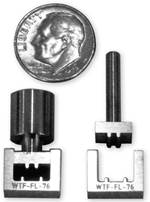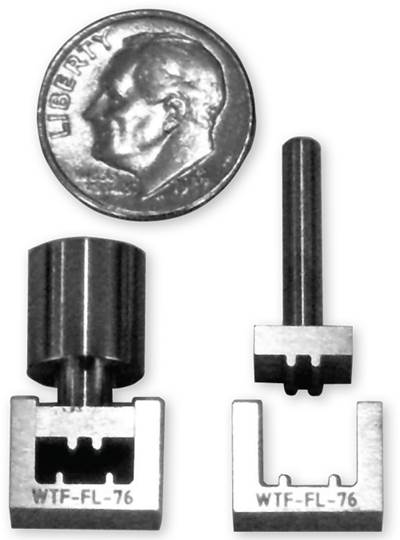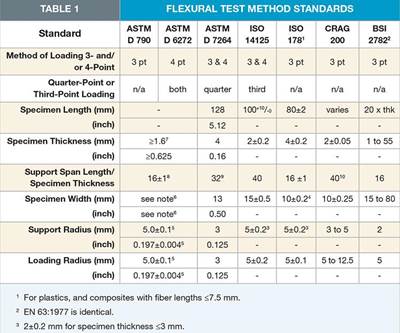Reversed loading flexural fatigue
Dr. Donald F. Adams, owner and president of Wyoming Test Fixtures (Salt Lake City, Utah) discusses reverse loading flexural fatigue testing and fixture design.
Static flexural testing has long been conducted because it is a simple method for evaluating all types of materials. Static flexural testing of composite materials, in particular, was discussed in my March and May 2013 columns (see ”Editior's Picks,” at top right). In all static flexural testing, the load is applied monotonically. That is, the goal is to bend the specimen in just one direction. The specimen, therefore, remains in contact with the support and loading points at all times.
Monotonic flexural static loading can be readily extended to monotonic flexural fatigue loading by taking into account what are only minor additional considerations. For one, it is typically necessary to constrain the specimen axially, to prevent it from “walking away” from under the supports with repeated cycling. Likewise, any lateral movement must be constrained. This must be done because the specimen is being subjected to loads that cycle between a selected maximum load and a load as low as zero. As a result, the outer surfaces of the specimen lengthen or shorten (depending upon whether that surface is the tension or compression surface). This, in turn, causes the specimen to slide on the supports during each cycle unless some provision is made to prevent it.
This sliding may or may not affect the specimen integrity and/or the test results, depending upon the type of material being tested, the specified load levels and the magnitude of the specimen deflections achieved, but in any case, it will cause wear of the loading and support surfaces of the test fixture. (My March 2013 column discusses types of supports available for use.) However, the problems encountered here are not too difficult to overcome, and for that reason, monotonic flexural fatigue testing is occasionally conducted.
In contrast, reversed loading flexural fatigue introduces a significant additional problem. Here, the specimen must be both pushed and pulled at each loading point, so it must be in contact with loading points on both of its surfaces. Additionally, the specimen also must be constrained on both surfaces at the support points to prevent the specimen from lifting off of the support points during half of each cycle.
The specimen can be constrained at the loading and the support points by clamping the specimen, with clamp faces positioned on directly opposing surfaces of the specimen at each point. Only a light clamping force is required to keep the fixture surfaces in contact with the specimen. However, the increased frictional resistance developed by using a greater clamping force will help prevent the “walking” action discussed above.
An additional consideration is that, by definition, the loading for reversed-cycle fatigue testing passes through zero during each cycle. And because the specimen is under no load at that instant, it is free to move if not constrained. Although friction forces developed by the clamps at the loading and support points might be sufficient to restrain this movement, any movement per load cycle, even if very small, will accumulate because a fatigue specimen might be subjected to a million or more load cycles. Thus, additional, more positive, constraint might be an option. For example, a pointed screw can be lightly pressed into each side of the specimen at each of the loading and support points, at the specimen mid-thickness (the neutral axis of bending stress). These screws prevent axial and lateral movement.
Finally, because the specimen is continually deflecting (bending) during each cycle, each of the loading/support clamps must be free to rotate so that they do not constrain the bending of the specimen as the test proceeds.
An example of a test fixture that meets all of the above requirements is shown in Fig. 1. The fixture’s base and loading beams are directly attached to the base and crosshead of a testing machine capable of applying an axial load in both tension and compression. The specimen loading and support span lengths can be varied by loosening the two bolts at the outer end of each loading/support assembly and sliding the assemblies along the beam to the desired position. These bolts can be seen at the top of the image in Fig. 1. As shown, the fixture is set up to perform four-point loading. For three-point loading, one of the loading head assemblies is simply removed and the remaining head assembly is moved to the center of the beam. (The comparative merits of three- and four-point loading have been discussed in my previous columns.)
A pivoting cradle is mounted in each loading/support assembly (the bushings in which the cradle axes pivot appear as white circles in Fig. 1). These particular bushings were fabricated of a Teflon polymer. Oil-impregnated bronze bushings are stronger, are fabricated to closer tolerances and, thus, are more suitable for high fixture loadings, but the Teflon bushings generate little friction and, therefore, wear very well.
The fixture shown has flat loading and support pads since it is designed to be used in sandwich panel testing. Alternatively, cylindrically shaped pads can be used — these are sometimes specified for solid composite laminates. The pads are clamped against the specimen by tightening the bolt in each clamp half. Using two bolts permits the user to accommodate specimens of different thicknesses while keeping the specimen centered in the cradle.
Although there has been some interest in reversed flexural fatigue testing of composites for many years, there is at the present time no ASTM standard for such testing. However, there is a relatively new standard for plastics, ASTM D 7774-12, “Standard Test Method for Flexural Fatigue Properties of Plastics,” which does include reversed loading. Further, reversed flexural fatigue testing of composites appears to be increasing significantly. This is, perhaps, an indication of this industry’s progress toward maturity — and the need for more realistic service data as composites applications become more demanding.
Related Content
Mechanical testing of ceramic matrix composites
Today’s CMC materials, robust and resistant to high temperatures, provide their own set of challenges when determining their performance through mechanical testing.
Read MoreCrashworthiness testing of composites: A building block approach, Part 1
Determining the crashworthiness of composite structures requires several levels of testing and analysis, starting with coupon-level crush testing.
Read MoreDevelopment of fracture mechanics test methods for sandwich composites: An update
An update on the CMH-17 Sandwich Disbond Working Group’s sandwich SCB test and two additional sandwich composite fracture mechanics test methods under development.
Read MoreCrashworthiness testing of composites: A building block approach, Part 3
Third in a series on crashworthiness testing analyzes the upper levels of the building block approach and the importance of numerical analyses.
Read MoreRead Next
Flexural testing of composite materials
Dr. Donald F. Adams (Wyoming Test Fixtures (Salt Lake City, Utah) takes look at flexural testing and promises recommendations, next time, for a unified standard.
Read MoreFlexural test method standards for composite materials
Dr. Donald F. Adams (Wyoming Test Fixtures Inc., Salt Lake City, Utah) proposes a common-sense standard method for flexural testing of composite materials.
Read MoreUltrasonic welding for in-space manufacturing of CFRTP
Agile Ultrasonics and NASA trial robotic-compatible carbon fiber-reinforced thermoplastic ultrasonic welding technology for space structures.
Read More





















